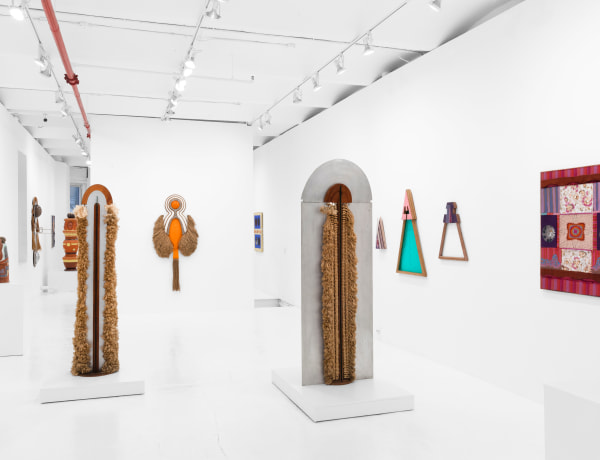
b. Holmes County, MS, 1940
Walter C. Jackson is a sculptor whose work combines natural materials—such as wood, sisal and jute fibers—alongside industrial plastic and aluminum. Jackson describes his practice as a “unity of opposites,” containing spiritual considerations—with symbolic reference to both African cosmology and Christian iconography influenced by his Methodist upbringing—within the structure of urban geometries. Jackson fuses traditional totemic forms and contemporary aesthetics of light, movement, and refraction.
Jackson’s sculptures are defined by their arched or triangular shape, which frames an opening through which the viewer can see and sometimes walk into. In the 1970s, Jackson was developing the idea of a passageway, a method of inviting the viewer to enter into the work and of creating a portal between concepts of ritual and technology, past and future. The artist’s structural framework draws upon West African Dogon sculpture, Moorish doorways in Spain, pyramidal constructions, and ecclesiastical architecture of the American South. Jackson is particularly interested in the icons of West African spiritual tradition, which he imagines contain an internal energy and give the illusion of being poised for movement. The artist seeks a similar kinetic quality through his use of human scale, electrical illumination, and hair-like filaments within his works. Through these material choices, Jackson channels diverse conceptions of the divine, invoking ancient and ritual traditions as well as contemporary worship via scientific and digital mediums.
Growing up in Jackson, Mississippi, Jackson had little access to examples of fine art in museums and galleries. He played the trombone in his school band before deciding to take drawing classes. Jackson completed his BS degree in Art Education at Jackson State University in 1963, where he began to conceive of himself as a painter and produced a series of portraits and landscapes. Although no sculpture classes were offered, Jackson was drawn to working 3-dimensionally after his design teacher provided him with wood carving tools. The resulting vertical steel and wooden constructions remained informed by his portraiture, imbued with an anthropomorphic quality and embracing the organic color and shape of his materials. Jackson went on to complete his MFA from the University of Tennessee, where he studied sculpture exclusively. During this time, Jackson was introduced to the African American Mexican artist Elizabeth Catlett in Cuernavaca, Mexico, where they exchanged ideas about casting in plastic and polyester resin. Catlett later invited Jackson to speak and present slides at the National Autonomous University of Mexico in Mexico City.
Jackson has a lifelong career as an arts educator. From 1963 to 1968, he headed the art department at Douglass High School in Memphis, Tennessee. He joined the faculty of the University of Tennessee in 1971, serving as an assistant professor of sculpture until 1980. In 1984, Jackson worked as an adjunct assistant professor at York College of The City University of New York for two years, before joining the Bronx Museum of Arts and eventually becoming executive director at the Bronx River Art Center in 1995.
Jackson is the recipient of many grants and awards including the NEA Artist in Resident at Bronx River Art Center, New York; New York Foundation for the Arts, and a NY state council for the Arts (CAPS) Grant. Jackson was selected for an artist-in-residence fellowship at the Studio Museum in Harlem in 1982 alongside Tyrone Mitchell and Janet Henry, and received the artist-in-residence fellowship at the Roswell Museum in 1994. He also completed the workshop residency at the Museum of Holography in 1987. His work is held in public collections, including the Tennessee State Museum, Nashville; New York Public Library, The Schomburg Center for Research in Black Culture, New York; The Studio Museum in Harlem, New York; and the Anderson Museum of Contemporary Art, Roswell, NM. Jackson lives and works in rural New York.